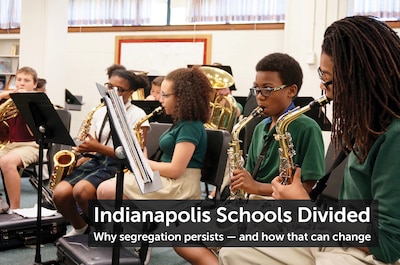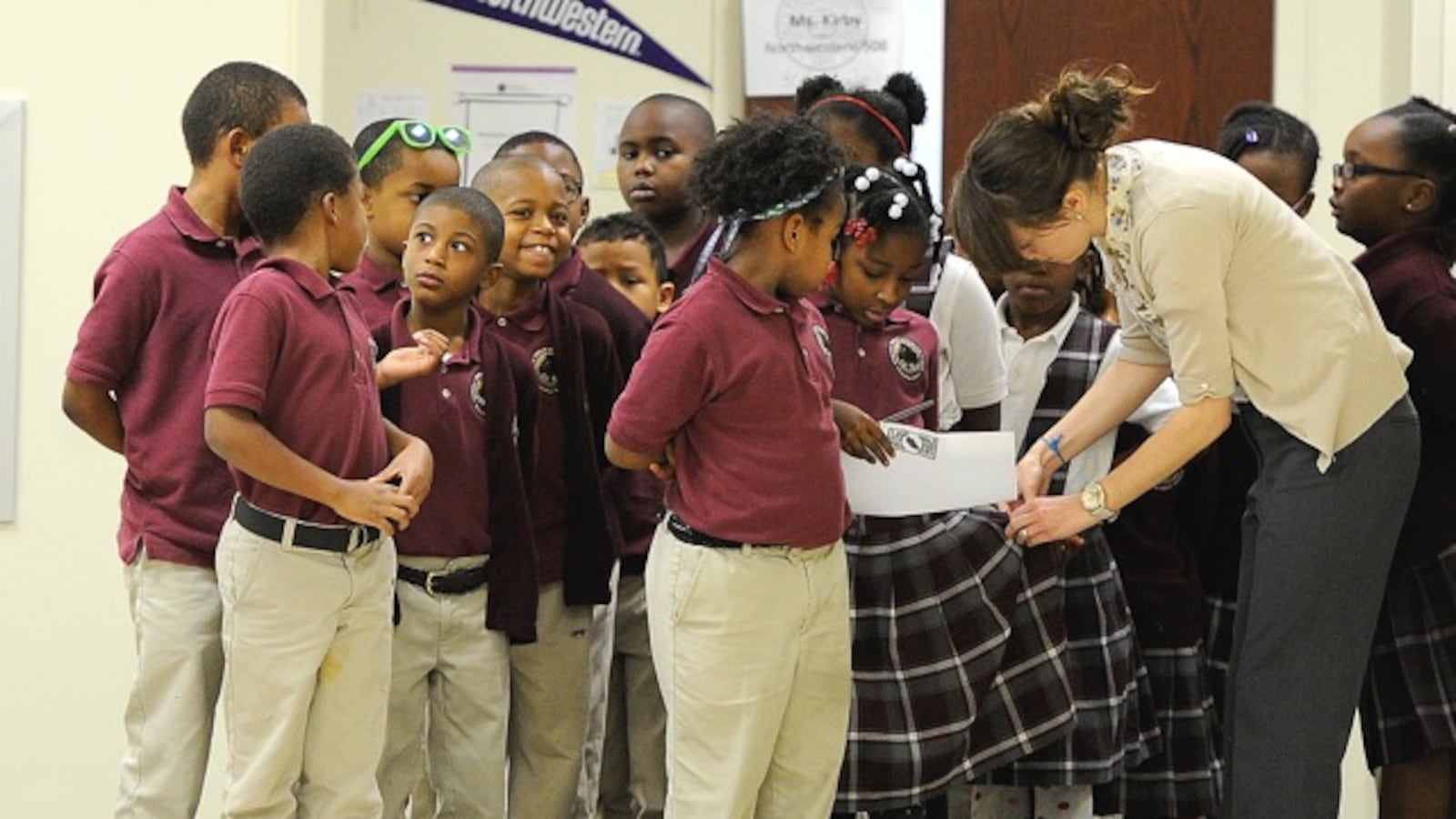When Kabrina Merriweather was an elementary student in Indianapolis Public Schools, her school was diverse and so were her friendships — her three closest friends were black, white and Asian.
But in middle school, Merriweather left IPS for a charter school and her classmates started to look a lot more alike.
Merriweather went to middle school in the Tindley charter school network. She thrived in Tindley, which has since grown to a network of five charter schools that consistently earns praise for rigorous standards and high test scores. She played basketball and picked up nearly a year’s worth of college credit.
“It was great,” said Merriweather, who returned last year to teach seventh grade at Tindley Collegiate Academy.
But she no longer sat every day beside children from racially and ethnically diverse backgrounds.
Schools in the Tindley network are among the most racially isolated in Indianapolis. More than nine in 10 Tindley students are black. Fewer than 2 percent are white.
Merriweather, who is African American, noticed that her middle school classmates were almost exclusively black, but it didn’t matter to her, she said.
“I was a nerd,” she said. “I was more into what I was going to learn and what it could offer me.”

Tindley is part of a broad national pattern. Racial segregation has been documented in charter schools across the country. Many have focused on serving low-income kids in black and Hispanic communities, where parents are often dissatisfied with their neighborhood schools.
But as charter schools expand their reach across the country and every year educate a larger share of the nation’s children, the issue of racial segregation has raised significant concerns among integration advocates who warn that it can push low-income students into low-achieving schools and reduce the resources going to high-needs schools.
Even at schools like Tindley that are relatively high performing, critics say graduates will be less prepared to interact with people from different backgrounds later in life.
Tindley says it takes steps to expose its students to children from different backgrounds through partnerships with other schools and through academic competitions. The network says it welcomes all students but school officials note that the Tindley network was founded to serve students in high-needs communities. The school draws most of its students from the heavily black neighborhoods surrounding its schools.
“The students in these neighborhoods are generally the students who are scoring the lowest on the state exams — are the students who aren’t getting the opportunities to go to college,” said Patrick Jones, a former principal and the current director of academics and culture at the network. “It’s not necessarily always because of bad schools. It could be because of poverty.”
And if the school is serving children’s needs, some charter supporters say focusing on integrating charter schools is a distraction.
Chris Stewart, outreach director for Education Post, an advocacy website that supports school choice, said charter schools primarily serve black and Hispanic students because those are the kids who haven’t had access to high-quality education in the past.
“There are many sophisticated ways in which white families get their kids into the type of school that they want,” Stewart said. “Charter schooling has been a boon for black choice and brown choice.”
Supporters of integration, however, say diverse schools can play a role in healing the distrust between people of different races and classes.
There’s strong research that integrated schools improve student outcomes, said University of New Orleans professor Brian Beabout. He helped found an intentionally integrated charter school in New Orleans in part because he wanted to create a place where his children could learn alongside kids from different backgrounds.
“We need to figure out how urban charter schools fit into the broader urban community that they are part of,” Beabout said. “I see the creation of diverse schools as one building, one way that we can start to build empathy for each other and interpersonal contact across these historic divides.”
In Indianapolis, where Chalkbeat, the Indianapolis Star and WFYI have been examining segregation and the forces shaping enrollment in a divided city, more IPS elementary schools are segregated today than were before busing began.
But charter schools are even more likely to be isolated by race. Of the 38 charter schools in Indianapolis, nearly half have enrollment that is over 75 percent black.
While one in four charter schools are over 90 percent black, IPS has just two schools where segregation is that extreme.
It’s not clear whether charter schools are making the city’s schools more segregated. But a recent study suggests that when Indianapolis students leave traditional public schools for charter schools, their new schools are less racially diverse.
When researcher Marc Stein looked at the Indianapolis students who transferred from an IPS school to a charter school, he found that families were sending their children to charter schools with more students of the same race. When white kids switched to charter schools, they had an average of 14 percent more white students than their prior schools, and when black kids switched to charter schools, they had an average 9 percent more black students. The only exception was Latino students, who actually switched to charter schools that had lower Latino enrollment, likely because the charter schools studied had very low Latino enrollment at the time of the study.
“Overall, kids were moving to less diverse environments,” said Stein, who was a Vanderbilt University graduate student at the time of the study and now teaches at Johns Hopkins University.
It’s not necessarily surprising that families who are choosing schools end up sending their children to less diverse schools, he said. When the Indianapolis families he studied chose schools, they tended to rely on word of mouth, learning about schools from friends, family and coworkers — communities that are often segregated as well.
“We tend to isolate ourselves with people who look like us, talk like us, have the same experience as us,” Stein said. “If we are making decisions based off of information from people that look like us, that might lead us to environments that are more like us.”
There’s a growing national movement to create integrated schools, and a handful of charter schools in Indianapolis do have integrated enrollment. But Stein said that it takes intentional work to reach out to families in different communities.
It’s not clear that recruiting more racially diverse student bodies is a priority for most Indianapolis charter schools.
The vast majority of the city’s charter schools are authorized by the mayor’s office and overseen by the Indianapolis Office of Education Innovation. Although director Ahmed Young said he values student and staff diversity at schools, he hopes to see schools become more diverse naturally as parents have access to more information through a proposed unified enrollment system.
Reducing segregation is not Young’s first priority.
“The most important thing is making sure that no matter what the composition of a school is, that they are receiving a high-quality education,” he said. “What’s key for me are the outcomes.”
At Irvington Community Schools, one of five majority-white charter schools in the city, school leaders are quick to say that it reflects the neighborhood demographics and welcomes any students who apply. Located on the near east side in a vibrant neighborhood that attracts young middle-class families, about 70 percent of Irvington students are white.
When Irvington opened 14 years ago, the aim was to give families who didn’t want to send their children to IPS an option other than moving out of the district or paying for private school, according to school leaders.
Irvington has done outreach to families by attending school fairs and bringing flyers to a nearby church with a heavily Hispanic congregation. In the past, they’ve put up billboards, sent out mailers and put advertisement in the community newspaper. They recruit high school students from charter elementary and middle schools that serve lots of black and Hispanic students. But they don’t do a lot of marketing.
Irvington, which has a waitlist and school admission lottery every year, primarily attracts families who have heard about the school from other students there, according to CEO Tim Mulherin.
“The people who come to us come to us,” Mulherin said. “We are not looking at color, we are looking at the people that are sitting in the chairs. … Whoever gets in to our school, we are going to educate them, and we are not creating roadblocks to that.”
But simply removing barriers may not be enough to integrate charter schools.
At the charter schools that were successfully integrating in Indianapolis, school leaders worked hard to recruit diverse students, Stein said. They took steps such as hiring Hispanic staff who were bilingual in Spanish and English and already enmeshed in the communities they were aiming to reach.
“It’s about where you put your efforts and what you focus on,” he said. “It’s the type of issue that requires frank, open discussion about what a community values and what it wants its schools to do.”

